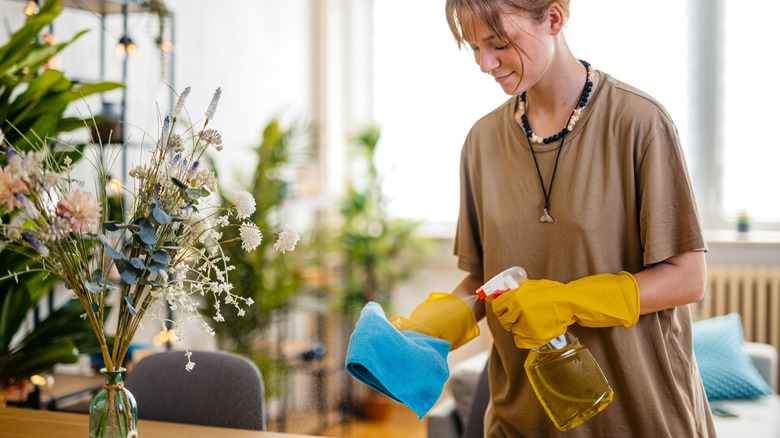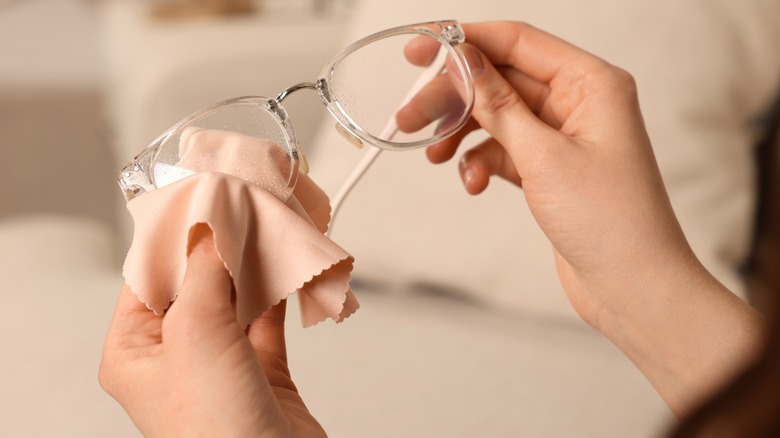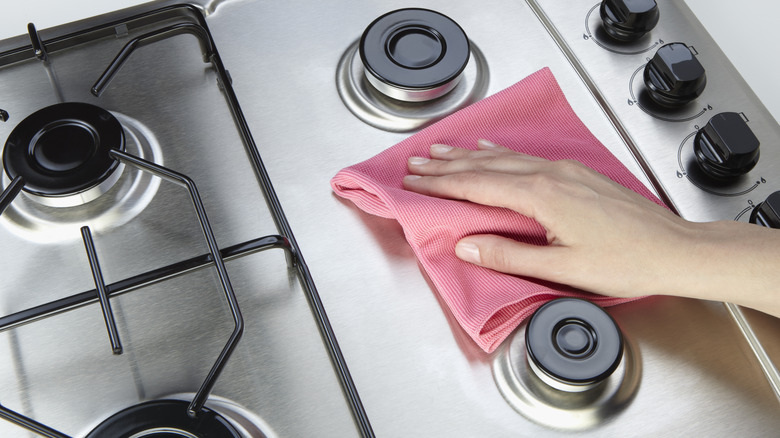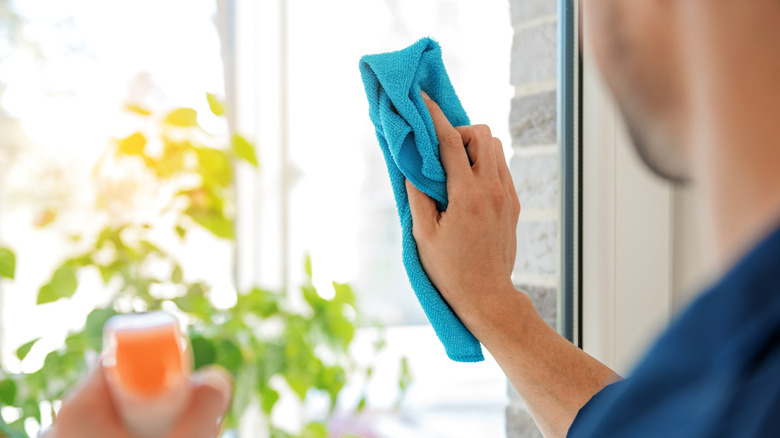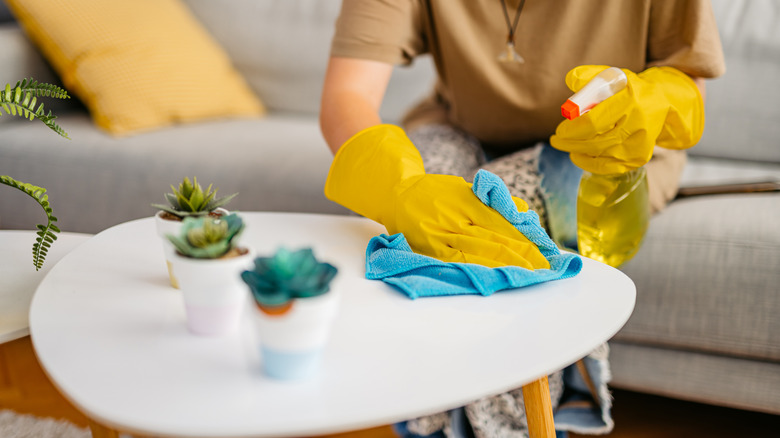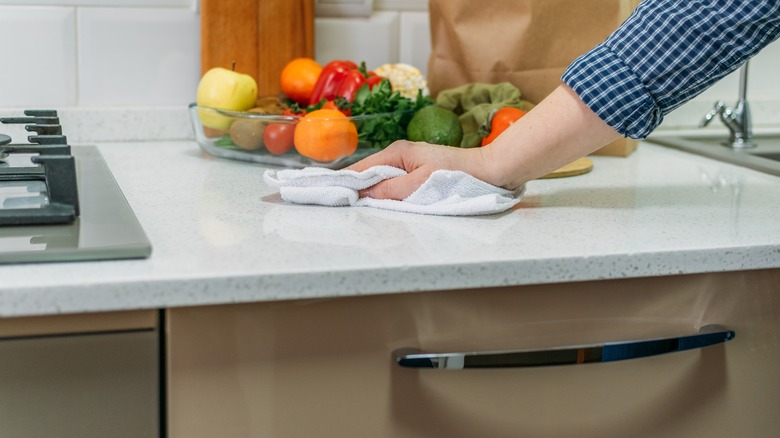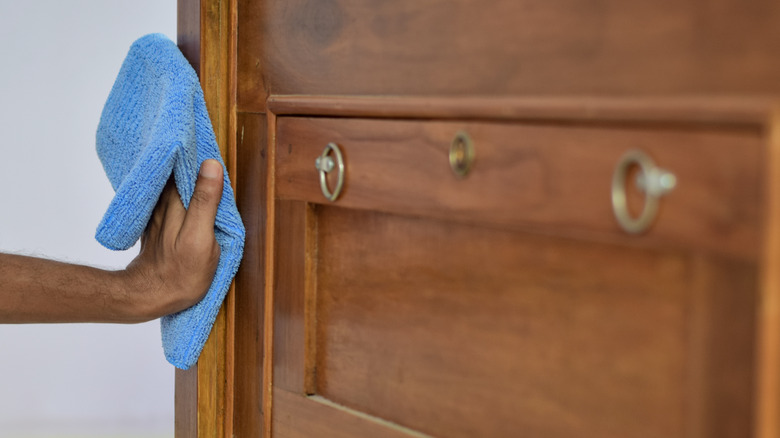Here's What You Should Be Cleaning With A Microfiber Cloth
What is the big deal with microfiber cloths? This product is not just your ordinary piece of fabric. Microfiber cloths are made up of incredibly fine fibers that are a fraction of the diameter of human hair. This seemingly minor detail is what makes them stand out in the cleaning game. These fine fibers have some serious cleaning superpowers as they can effectively trap dirt, dust, and even microscopic particles. And here's the kicker: They do it without scratching or damaging the surfaces they're cleaning.
What's truly amazing is the versatility of these little wonders. From cleaning your eyeglasses to wiping down your car's dashboard, microfiber cloths can handle it all. They're your trusty companion for gently polishing windows and mirrors, making them gleam without a streak in sight. Got stubborn kitchen spills or bathroom grime? Microfiber cloths swoop in to save the day, effortlessly tackling messes without leaving behind lint or residue. Plus, they're eco-friendly, reducing the need for harsh chemicals in your cleaning routine. Let's take a closer look at nine things you should be cleaning with a microfiber cloth.
Electronic screens and devices
Electronic devices have become an integral part of our lives, and microfiber cloths are the ultimate resource in keeping them clean. Their ultra-fine fibers work like magic to gently whisk away fingerprints, smudges, and dust without leaving a trace. And the best part is you don't need any special cleaning solution. These cloths are designed to do their thing without the need for any harsh chemicals or liquids. You're more than welcome to use a screen-cleaning product, but save that for when you do deep cleaning. For regular, run-of-the-mill smudges and imperfections, simply give your screen a quick wipe-down, and you're back to enjoying that crystal-clear display.
Because we use our electronic devices, particularly smartphones, on a consistent basis, it's a good idea to clean your screens regularly. The ideal frequency depends on your usage, but a once-a-week cleaning session is a solid goal. Make it part of your Sunday routine or when you're tidying up. So, the next time you see your laptop, tablet, or smartphone screen looking a little worse for wear, don't reach for your shirttail. Instead, reach for that trusty microfiber cloth hanging out in your cleaning arsenal.
Eyeglasses and sunglasses
If your eyeglass lenses are smudged, you may squint more than usual to try and see through them. This can then lead to tension headaches, which hinder productivity and focus. Microfiber cloths make for incredible cleaning tools for your eye and sunglasses. Their super-fine fibers banish smudges, fingerprints, and dust with a swish and a swipe. They lift away particles without scratching or leaving lint behind, which gives you a crystal-clear vision without compromising the integrity of your lenses. And getting your lenses clean with a microfiber cloth is pretty straightforward, making them an even better addition to your cleaning kit.
First, make sure the cloth you're using is clean so you don't spread dirt around your lenses. Begin by gently brushing off any loose particles. Then, rinse your lenses under some lukewarm water to wash away any stubborn grime. After that, pat your lenses dry with the microfiber cloth. And remember, there is no need for aggressive scrubbing. Let the fabric do its thing with a gentle touch. If you are outdoors often or use your glasses daily, a quick clean once or twice a day is a good rule of thumb. If you're more of an occasional wearer, a couple of times a week should keep things crisp and clear.
Stainless steel appliances
Stainless steel appliances are fairly common in most modern-day kitchens, but keeping them smudge and streak-free can feel like a never-ending battle. Microfiber cloths are the perfect match for these products, and it's all in the fabric. Those teeny-tiny fibers are like a superhero squad that banishes dirt without scratching the surface. No more worrying about abrasive scrubbers leaving unsightly marks on your appliances. Plus, these cloths don't just push the dirt around; they trap it, leaving your surfaces genuinely clean.
A microfiber cloth can clean these appliances on its own with just a little bit of water. But if you're dealing with stubborn grime or smudges that refuse to budge, a mild mixture of dish soap and water can be your secret weapon. Since you don't want to leave behind any residue, go for less is more by using two to three drops of dish soap. If that hasn't done the trick, add another drop or two. When it comes to the frequency of these cleaning sessions, it's more about consistency than intensity. Giving your stainless steel appliances a quick wipe-down once or twice a week can help keep them looking their best.
Car interior and exterior
Believe it or not, microfiber cloths can transform your car cleaning game, both inside and out. When it comes to the interior, these cloths are gentle yet effective, perfect for wiping down dashboard surfaces, cleaning dusty air vents, and even tackling the grime that appears on your steering wheel. Since microfiber cloths are non-abrasive, you can trust them to pamper your car's interior materials, whether it's leather, plastic, or cloth. And here's a secret: They're also great for cleaning those hard-to-reach nooks and crannies, like around your gear shifter or between your seats.
On the exterior side of things, your car deals with a lot, and these cloths can help with just about all of it. The soft fibers help lift away dirt and grime without scratching your car's finish, and they're perfect for applying a gentle touch when drying after a wash. You can even use them to apply wax or polish for that extra layer of protection and shine. If you're a car enthusiast who loves keeping your ride looking its best, consider investing in a few different colored microfiber cloths. You can use one color for the body, another for the windows, and another for the wheels. Essentially, you can build an incredible cleaning kit for your daily ride.
Windows and mirrors
Due to their intricate fibers, microfiber cloths offer exceptional cleaning capabilities for glass surfaces, such as windows and mirrors. The fine fibers form a structure with a high surface area, enabling them to effectively capture and eliminate dirt, smudges, and fingerprints. This intricate design minimizes the need for excessive rubbing and pressure, which in turn reduces the risk of scratches or damage to the glass. Unlike traditional paper towels that can leave lint or streaks behind, microfiber cloths ensure a streak-free finish, leaving your windows and mirrors crystal clear.
Though you may be tempted to spray the glass with a cleaning solution, microfiber cloths clean just as well without the addition of one. In most cases, using a slightly dampened cloth is sufficient to remove everyday dirt and smudges. For more stubborn stains or buildup, a mixture of 1 cup of water and 1/2 cup of vinegar can be applied sparingly. It's important to avoid oversaturating the cloth or the glass surface. Always remember that less is more, especially when cleaning delicate materials like glass. You'll want to schedule weekly cleaning for these surfaces to ensure long-lasting effects. Windows or mirrors prone to smudges may benefit from more frequent cleaning, but once a week is often enough to keep them clean.
Regular household dusting
Microfiber cloths are an efficient solution to the perpetual task of dusting in households. Their electrostatic properties enable them to attract and capture not only visible dust but also microscopic particles, minimizing the presence of allergens and creating a more thorough cleaning experience. This feature sets them apart from traditional dusting methods, like cotton. Cotton merely moves dust and particles around while microfiber traps them. Cotton also leaves behind residue such as lint, which doesn't make it feel like you cleaned at all.
The utility of microfiber cloths extends beyond general dusting to encompass the care of delicate collectibles and fragile decorative items. Their soft and non-abrasive composition makes them suitable for cleaning sensitive objects without the risk of causing scratches or damage. To avoid loose particles sticking to these surfaces, gently shake the cloth outdoors before cleaning a new area of your home. You can even add a microfiber cloth to the end of a flathead mop, like a Swiffer, and use that to dust your hardwood floors. If you incorporate regular dusting sessions, especially in areas prone to collecting dust quickly, you will effectively prevent accumulation and preserve the cleanliness and aesthetic appeal of your living environment.
Kitchen countertops
Kitchen countertops often bear the brunt of daily food preparation and activity, accumulating a variety of substances that demand regular cleaning. From oil splatters to coffee stains and food crumbs, microfiber cloths are adept at tackling these common challenges. The fibers capture crumbs and spills rather than pushing them around as traditional cleaning cloths or paper towels might. This ability to lift and hold onto dirt ensures that your countertops are left thoroughly clean without unsightly streaks or residue. Because microfiber is non-abrasive, they're suitable for various countertop materials, such as granite, quartz, marble, and more.
Establishing a routine cleaning regimen by wiping down your countertops once a day, particularly after cooking and meal prep, can help maintain their cleanliness and extend their longevity. However, if you've had a particularly intensive cooking session or find that your countertops require extra attention, don't hesitate to give them a quick wipe with your trusty microfiber cloth. For daily wipe-downs, a damp cloth will be sufficient enough. For deeper cleaning, consider spraying the countertops with an all-purpose cleaner that's safe for the surface you have, and use the cloth in conjunction with it.
Bathroom surfaces and walls
When it comes to maintaining your bathroom's cleanliness and hygiene, microfiber cloths are indispensable allies. Their unique structure, composed of those ultra-fine fibers, enables them to excel in removing dirt, soap scum, and grime from various bathroom surfaces. The threads act like tiny hooks, effectively capturing particles and debris without causing scratches or damage. This quality is especially crucial for surfaces that can be sensitive to abrasive cleaning methods.
Whether it's the daily splashes on your sink, the toothpaste residue on the mirror, or the buildup on your shower walls, these cloths can handle them all. Establishing a regular cleaning routine is key to maintaining a hygienic bathroom space. Make it a habit to wipe down the area every few days. This will prevent the accumulation of grime and ensure a pleasant bathroom experience. Additionally, microfiber cloths can extend their utility to cleaning bathroom walls, which are prone to moisture and the growth of mold and mildew. Regularly wiping down bathroom walls with a damp microfiber cloth can help mitigate these concerns and keep your bathroom looking and smelling fresh.
Wooden furniture
Microfiber cloths emerge as the ideal choice for the care and maintenance of your wooden furniture. Their soft and finely woven fibers are well-suited for removing dust, dirt, and particles from wood surfaces without causing any scratches or abrasions. This gentle touch is particularly important for preserving the finish and overall appearance of the wood. Unlike traditional cleaning cloths that might inadvertently leave behind lint or push particles around, microfiber cloths capture and retain dirt, ensuring your furniture is left clean and free from residue.
When cleaning wooden furniture, using a dry or slightly damp microfiber cloth is often sufficient to achieve optimal results. If your furniture requires a more thorough cleaning, you can lightly dampen the fabric with a mixture of water and a mild wood cleaner. This approach ensures that you're using a safe and effective solution that won't harm the wood's finish. Wiping down surfaces once or twice a week, or as needed, can prevent the buildup of dust and dirt that might otherwise cause surface damage. By integrating microfiber cloths into your furniture care routine, you're taking a proactive step towards maintaining the timeless beauty and longevity of your beloved wooden pieces.
